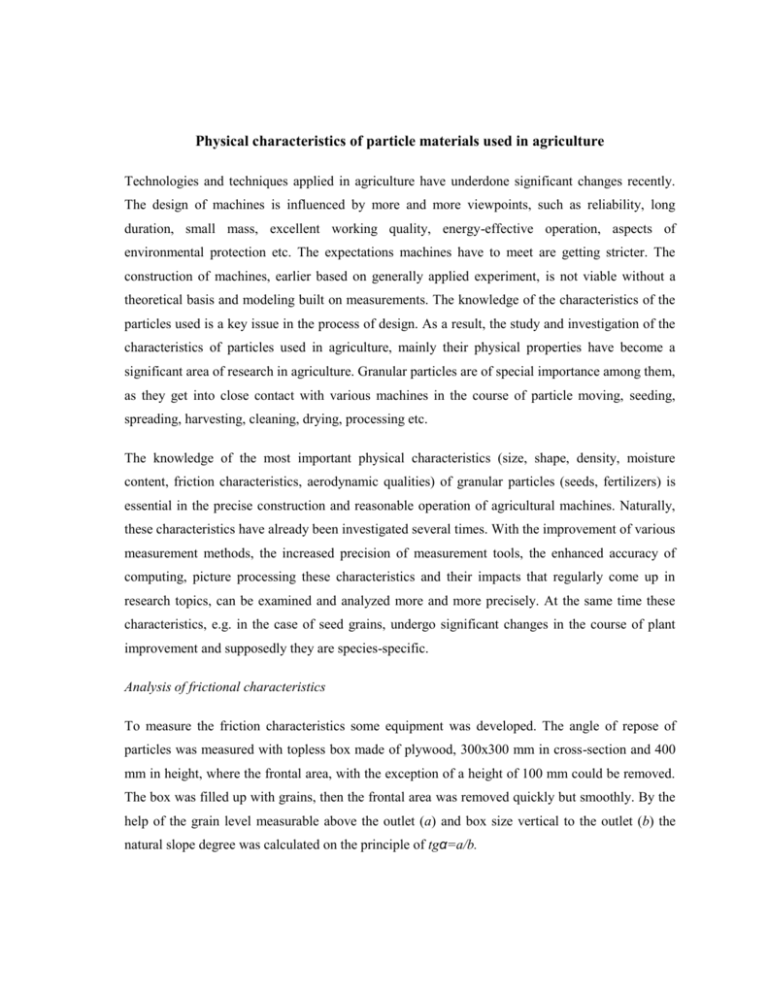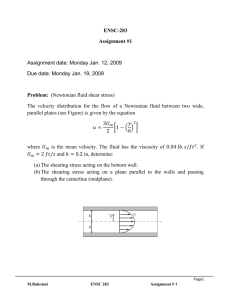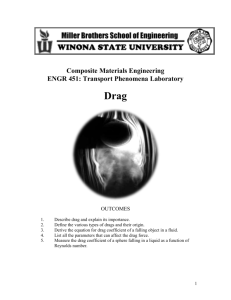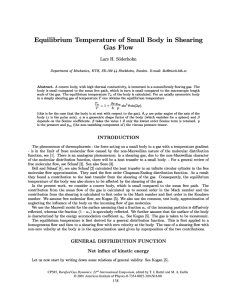Technologies and techniques applied in agriculture have
advertisement

Physical characteristics of particle materials used in agriculture Technologies and techniques applied in agriculture have underdone significant changes recently. The design of machines is influenced by more and more viewpoints, such as reliability, long duration, small mass, excellent working quality, energy-effective operation, aspects of environmental protection etc. The expectations machines have to meet are getting stricter. The construction of machines, earlier based on generally applied experiment, is not viable without a theoretical basis and modeling built on measurements. The knowledge of the characteristics of the particles used is a key issue in the process of design. As a result, the study and investigation of the characteristics of particles used in agriculture, mainly their physical properties have become a significant area of research in agriculture. Granular particles are of special importance among them, as they get into close contact with various machines in the course of particle moving, seeding, spreading, harvesting, cleaning, drying, processing etc. The knowledge of the most important physical characteristics (size, shape, density, moisture content, friction characteristics, aerodynamic qualities) of granular particles (seeds, fertilizers) is essential in the precise construction and reasonable operation of agricultural machines. Naturally, these characteristics have already been investigated several times. With the improvement of various measurement methods, the increased precision of measurement tools, the enhanced accuracy of computing, picture processing these characteristics and their impacts that regularly come up in research topics, can be examined and analyzed more and more precisely. At the same time these characteristics, e.g. in the case of seed grains, undergo significant changes in the course of plant improvement and supposedly they are species-specific. Analysis of frictional characteristics To measure the friction characteristics some equipment was developed. The angle of repose of particles was measured with topless box made of plywood, 300x300 mm in cross-section and 400 mm in height, where the frontal area, with the exception of a height of 100 mm could be removed. The box was filled up with grains, then the frontal area was removed quickly but smoothly. By the help of the grain level measurable above the outlet (a) and box size vertical to the outlet (b) the natural slope degree was calculated on the principle of tgα=a/b. A friction-measuring device examined the inner friction of materials and the slide on the surface. The device contains a shearing box of two pieces with a cross-section of 200x 200 mm and with inner height of 60 mm, the shearing slot between the two can be adjusted with screws. In the course of measuring the lower frame of slight resistance, moving on a row of balls gets removed. A singlephased engine of 220V/50 Hz moves the drag frame by the help of diverting switches, back and forth. Between the drag frame and the shearing box a flat-link chain driven by a chain wheel establishes the link. The cell that measures the drag force is built in the vertical pulling arm of the drag chain. Dislocation and at the same time drag velocity were measured by an incremental rotating transducer, producing 2000 signals per rotation. A cell to measure the power with the range of 1000 N is adjusted to the top of the shearing box. Loading is performed by the help of a system of arms, with weights placed on the scales, at a gear transmission of 25x. The equipment for the investigation of friction can be supplied with a rotating shearing apparatus to measure the inner friction. The apparatus consists of two rings with an inner diameter of 400 mm, out of which the upper one is standing and loading, the bottom one can be turned on the sides. The diameter of the core parts of the rings is 100 mm. The planes partition the inner space of the rings into compartments in 120o. A flat-link chain over the outside mantle of the ring moves the bottom ring. In other respect, the apparatus is similar to the shearing box. Analysis of aerodynamic properties We have developed a vertical wind tunnel to analyze the movement of particles in the air. A radial blower with variable rpm supplies air stream. The air traverses from the blower to the plenum chamber, where the rectifier and the screens can be found. Air gets to the velocity test section of the tube through a confusor in the shape of a quarter of a circle. The test tube of 400 mm is perforated, thus an air velocity decrease of 20% is induced along the tube. An inclined tube manometer and a heat ball anemometer measure air velocity. The apparatus is equally capable of measuring the suspension velocity of individual particles.











